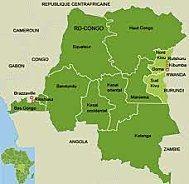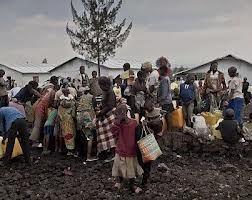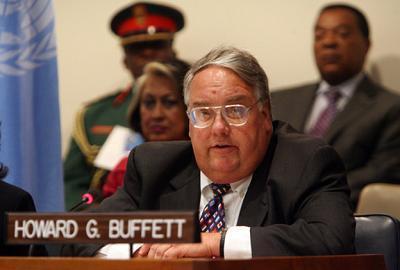
North and South Kivu provinces of the Democratic Republic of Congo
Colonialism dies hard.
And when the story of the hunt continues being written by the hunter, obviously the lion gets portrayed negatively.
They know what they are doing. And they have been operating that way for centuries. It’s the same pattern since the first Europeans entered Africa searching for riches and slaves.
They, it’s mainstream media [The New York Times and its peers in the West] and global corporations which are massively benefiting from the chaos that they are contributing to in the Democratic Republic of Congo.
In order to sustain their domination at the expense of others, they are supporting directly and indirectly their proxies in the region. These are Paul Kagame, president of Rwanda, and Joweri Museveni, President of Uganda, and their multiple militias on the ground in Eastern Congo.
It has been widely documented by numerous UN and other independent reports over several years that these militia which are on the payroll of Rwanda and Uganda are raping women, killing civilians, depopulating entire regions for mining and other resources.
During this festive season millions of electronic devices manufactured with blood minerals from the Democratic Republic of Congo will be exchanged making colossal profits for global corporations.
Money is being made with African blood as at the time of slavery. But scapegoats are required to calm the civilizing conscience.
Two recent concrete examples of the picture highlighted here are necessary for illustration.
$500,000 for Kampala peace talks from Howard G. Buffett
It must be only Howard G. Buffett, Kabila, Kagame and Museveni who believe in Kampala peace talks. Authentic Congolese people understand well that negotiations are being held between partners in crimes.

Displaced people in North Kivu
What is happening in Kampala between Kinshasa and M23 refers to what I have come to call insanity. People have been there before.
The contribution of Howard G. Buffett brings however a new dimension to what is going on. As the discussions are almost about the future balkanization of the Democratic Republic of Congo, one cannot stop from thinking of the Belgian King Leopold II during the Berlin Conference of 1885 which decided which portion of Africa would belong to who.
And when one also takes the similarities to the number of victims that the philanthropist King caused among Congolese people [10 millions] and today’ death toll in DRC, the tally is getting closer, if it isn’t yet.
The only difference from the past is that this time the partition of a significant piece of Africa is being discussed by paymasters’ agents, being coordinated from afar if not directly.
News of Rwanda explains Howard G. Buffett’s contribution to the Kampala talks.

Howard G. Buffett – (Photo – Getty Images)
“The Howard G. Buffett Foundation, linked to American billionaire Warren Buffett, has pledged US$500,000 to facilitate ongoing negotiations between the DRC government and M23 rebels in Uganda, it was announced on Monday. The contribution was announced by Howard G. Buffett, President of the Foundation, upon returning from one-on-one meetings in the region with DRC President Joseph Kabila, Rwanda’s President Paul Kagame and Uganda leader President Yoweri Museveni, who is also the facilitator of the talks.”
FDLR narrative
When the New York Times published a documented account of how Ambassador Susan Rice had shielded the Rwandan regime from international sanctions for its role in the Democratic Republic of Congo, many of us particularly from the Great Lakes region thought that the newspaper had finally decided to do the right thing by a u-turn in its persistent support of the Rwandan Patriotic Front since the genocide of 1994.
But we were completely in the wrong. This was particularly confirmed a few days later, once the ambassador had withdrawn herself from the nominees for the Secretary of State role.
The newspaper came back even with all its teeth out to its usual narrative to justify the presence of Rwandan forces in DRC.
The argument of Susan Rice protecting Paul Kagame from sanctions had been advanced and seemingly highlighted for simply stopping the ambassador from becoming Secretary of State, because White America wouldn’t have willingly found acceptable that the two most prestigious positions in the country be held by Black people. I may be wrong.
But how the newspaper was so teeth out on the FDLR narrative this time?
Though several UN reports have listed numerous Western companies benefiting from the intentionally created chaos that DRC has become the theater nowhere in its reporting the New York Times ever points seriously a finger to the responsibility of these global corporations.
It’s all tribal: the eternal cliché of black Africa.
“Eastern Congo is blessed with gold, coltan, cassiterite and other minerals. These easy-to-move riches, along with longstanding ethnic tensions and a dysfunctional central government, have become a toxic brew that has killed countless Congolese.”
Ethnicity has even become so centered on Hutus and Tutsis in the Kivus that no other tribes seem to exist anymore in the region. When one reads the newspaper with reference to these two communities, one would think that they are reading about the Rwanda of 1994.
“Many aid workers said ethnic tensions in the Goma area were increasing and could set off bloodletting between Hutus and Tutsis and other ethnic groups that may align themselves with either side.”
But people should wonder how these two communities are distributed in the Kivus compared to other Congolese ethnic groups.
Are the hundreds of thousands Congolese populations that are constantly being on the move surviving in horrible conditions, chased by M23, when they are not simply killed, or raped, all Hutus and Tutsis in waiting to reproduce the Rwandan genocide on Congolese soil?
The cream of the story is crowned with the FDLR reference. It almost indicates how the New York Times views can prevent another genocide of Tutsis, ignoring deliberately that the UN Mapping report accuses the Rwandan Tutsi-led government of Paul Kagame of having committed against Congolese people, Hutu Congolese and Rwandan Hutus refugees, crimes against humanity, war crimes and other crimes of genocide nature if they were to be brought in front of a court.
The newspaper writes:
“The F.D.L.R. is commanded by ethnic Hutus and includes remnants of the force that committed genocide in Rwanda in 1994, when hundreds of thousands of ethnic Tutsis were hacked to death. Humanitarian groups said that in the last week, militia fighters, including from the F.D.L.R., as well as from another militia group known as the Mai-Mai, have infiltrated some of the displaced persons camps ringing Goma with the cooperation of the government’s army. Aid groups are worried that the militants may try to use the camps as a springboard to wage attacks against Tutsi-led Rwanda. This is what happened in the mid-1990s, setting into motion a series of events that culminated in Rwanda invading Congo and helping to topple its government.”
With such description of this horrible threat on Rwandan Tutsis that Paul Kagame is protecting in Rwanda, who on earth could come up logically with sanctions against his officers and government officials who are working closely with the rebel group M23 which is his creation in join partnership with Joweri Museveni of Uganda?
That’s the intention of the New York Times of ensuring that the Rwandan regime, despite the serious and compelling evidence of its involvement in providing recruits and intelligence, arming, training, and co-ordinating M23 military operations, is not sanctioned.
And what is the real situation of the FDLR?
For more than ten years, the rebel group has been inactive. Under Laurent Desire Kabila it helped his regime to hold back Paul Kagame and his peer Ugandan and Burundian forces when they invaded the Democratic Republic of Congo for the second time in 1998.
After the assassination of Laurent Desire Kabila in January 2001, Joseph Kabila disowned the alliance that existed between the two sides. Some of the FDLR leaders were indicted by the International Criminal Tribunal for Rwanda for example colonel Renzaho and taken to Arusha, others were assassinated by Kagame’s networks in the Kivus, finally others left the group for exile in different countries. Colonel Rwarakabije, one of its top commanders joined the Rwandan Defence Forces with a hundred of rebel soldiers. He is currently the National responsible of Rwandan prisons.
Does the FDLR constitute today a threat to Rwanda? No, it does not in its present structures. But the Rwandan president needs something to showcase to justify its necessary presence in the Democratic Republic of Congo.
He will go as far as simulating FDLR attacks as he has over the years manipulated insecurity inside Rwanda and outside to justify particular political and strategic actions.
The cynicism about these rebel groups is so that if they didn’t effectively exist, the two dictators of the region, Paul Kagame and Joweri Museveni, would fund their existence because this serves a fundamental purpose for these leaders political survival.
But why would the New York Times side so openly with these criminal presidents of Rwanda and Uganda who are killing and oppressing their own people in the millions persistently and for so long periods of time?
It’s not tribal. And it has rarely been. But it’s always business, like in old times. There are stakeholders’ interests that need to be protected at any cost, including with lots of African blood.
